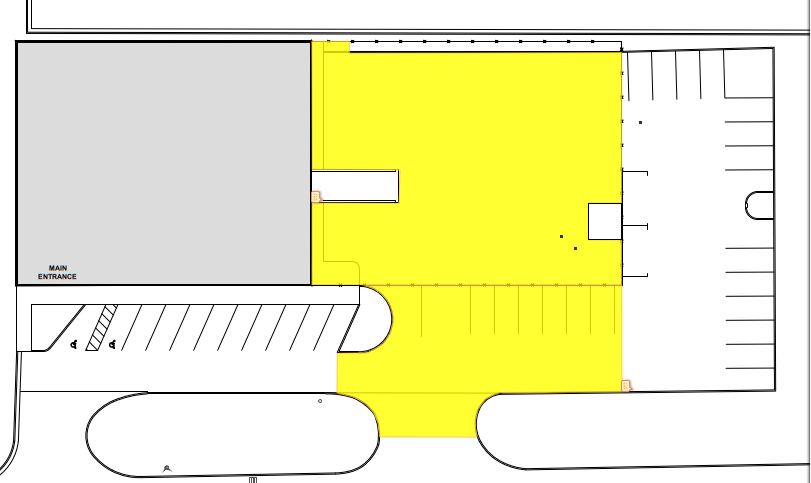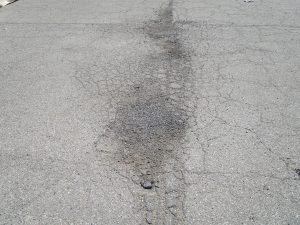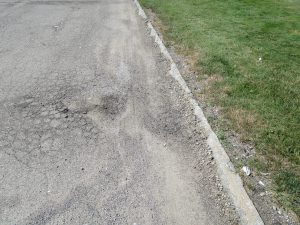
By Dan Wilson, PE
Senior Consultant
DWilson@benchmark-inc.com
It can be very challenging to decide what area of pavement at your facility is a priority when it is time to perform maintenance or reconstruction. If your facility has not implemented a timely and consistent preventive maintenance plan or a structured pavement rehabilitation program, the cost in an initial startup year may come as a shock. Adapting to budget constraints and making the right choices can be difficult. Following is an example of a tough budgeting and sequencing decision that needed to be made on a recent paving project:
Typical reflective cracking is progressing to severe deterioration and is an indication of underlying issues.
A client of Benchmark requested a site-wide pavement evaluation. Since the 1999 building purchase, the parking lot had very little maintenance performed. The limited maintenance performed consisted of emergency pothole repairs or repairs to small areas of failed pavement. The parking lot was initially constructed in 1989, using concrete pavement throughout. In this region of the country, concrete pavements typically last 20 to 30 years (with some maintenance). Just before the building purchase (1999 with then a 10-year-old concrete pavement), the pavement had a thin asphalt overlay installed over the concrete surface. This very early installation of an asphalt overlay installed on the concrete surface was very concerning and questions the integrity and quality of the original concrete pavement installation. There were pavement distresses present such as severe concrete pavement failures, widespread reflective cracking, severe curb deterioration, and settlement throughout the front lot, approaches, and receiving area.
During our inspection, the site contact provided insight into some of the prior pavement repairs. The client said, “When asphalt repairs were performed in previous years, the concrete appeared deteriorated down to the reinforcing steel.” Deterioration of this type cannot, for the long term, be maintained adequately with localized repairs; this is usually a widespread material or workmanship issue. While full-depth reconstruction (which requires full pavement removal) may seem costly, it is the proper way to repair a pavement with severe and widespread deficiencies that were present throughout this site.
A recommendation of a full pavement reconstruction for 70 percent of the pavement area was made, due to severe surface deterioration and lack of proper maintenance. This reconstruction would remove and eliminate the severely failing concrete base pavement beneath the asphalt surface. Budget figures included pavement reconstruction (70 percent of the area) with minor preventive maintenance (30 percent of the area) in lower use areas, which totaled over $310,000. This amount was, however, a figure the client could not afford.
Typical deterioration in the concrete curb is evidence of the condition of the pavement below the asphalt.
The client requested that we prioritize the needs and decide what to do if we owned the property. In response, we offered the following synopsis:
From a logical business perspective, the typical priority would be addressing customer-focused areas first (which in this case included the front lot and approaches), then focus priorities on the shipping and receiving areas. From a logical construction perspective, reconstruction would begin in areas that future reconstruction would not cross previously reconstructed pavement. This scenario would lead to the reconstruction of the receiving area first, then the front lot, followed by the driveway approaches. Maintenance work in the back lot would follow in either of these scenarios since it requires some preventive measures to prolong the life of the asphalt overlay over the concrete in this less distressed pavement.
In any case, the client would have the option to stage the construction over a two- or three-year period. Regardless of whatever direction was selected, reconstruction should be completed on an entire section with in each year.

The area in the yellow is the section the owner decided to focus on during the first year of reconstruction.
In this example, the most cost-effective and logical construction sequencing was selected, at the sacrifice of postponement of pavement work within the customer parking areas. Functionality for facility operations was weighed and ranked higher for their priorities. Reviewing pros and cons along with the associated cost impact helped this client make a decision that was right for them.


